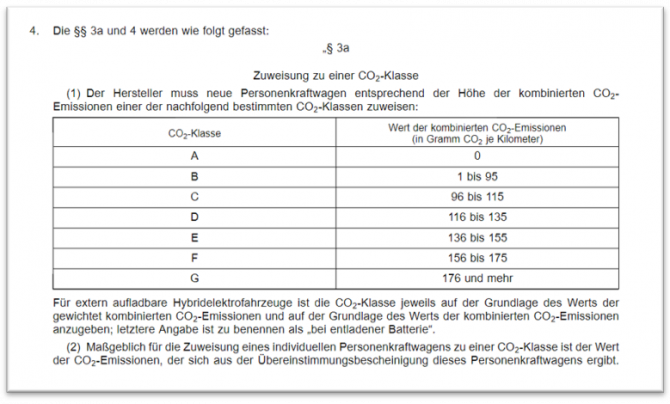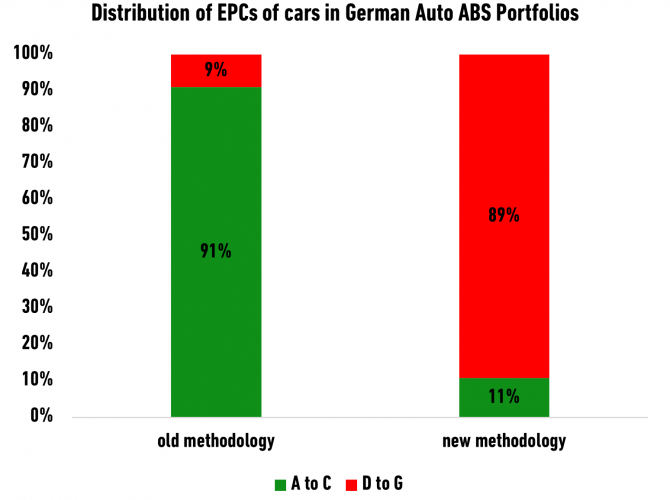Significant Changes to the CO₂ labelling Ordinance for Cars in Germany
The new Car Energy Consumption Labelling Ordinance came into force on 23 February 2024, drastically changing the energy performance labels assigned to cars, and has been mandatory since 1 May.
The new CO2 labels will use absolute CO2 emissions values and assign a rating based on thresholds as shown below.
Source: Car Energy Consumption Labelling Ordinance
In conjunction with EDW’s Q2 Research Update webinar , a LinkedIn survey was conducted to gauge public opinion on how the energy performance certificate (EPC) rating for a popular car model used by many German Taxi services might rank under the new Ordinance.
Fifty percent of voters selected the rating of B – C for the Mercedes-Benz E 220 d (2016-2020 model, 2L), however EDW estimates suggest that, under the new methodology, this car model would be assigned a D – E rating – a significant decrease from the A+ rating it received according to the old methodology.
THE IMPACT OF WEIGHT ON VEHICLE EPC RATINGS
EDW has previously compared energy performance ratings in Germany and France assigned to small cars (such as the Fiat 500) and larger cars (such as the Land Rover SUVs), using the old methodology and the EPC data reported to its securitisation repository platform via the ECB and ESMA templates for underlying exposures of auto and leasing ABS deals.
In France, the Fiat 500 was predominantly rated C or better (high energy efficiency), whereas the Land Rover SUVs were mostly rated D or worse (low energy efficiency). Conversely, under the old methodology in Germany, the Fiat 500 was considered energy inefficient, while the Land Rover SUVs were mostly rated as energy efficient.
The previous methodology was often criticised for not considering the weight of the vehicle. This meant that a large car with higher CO2 emissions could be assigned a better energy rating than a smaller car. Rather than basing the calculation solely on the CO2 emissions values, the methodology considered the CO2 emissions values in relation to the vehicle weight.
Since EDW has also enriched its dataset with estimated CO2 emissions for all auto-related loan-level data on the platform as part of the GAS project, a new comparison has been conducted, assigning EPCs to these models in Germany using the thresholds defined by the new methodology.
Under the new German Ordinance, which appears to be even stricter than the French methodology, the smaller Fiat 500 is rated as energy inefficient in 3 out 4 cases and the larger Land Rover SUVs are almost always rated inefficient.
WHY VEHICLE TESTING STANDARDS MATTER WHEN DETERMINING EMISSIONS
The result of the analysis detailed above raised some questions as to why the smaller Fiat 500 would be assigned a worse EPC rating under the new methodology.
One reason for this discrepancy could be attributed to the second major change in the Ordinance, i.e. the use of the Worldwide Harmonised Light Vehicles Test Procedure (WLTP) instead of the New European Driving Cycle (NEDC).
This new global standard aims to assess the emissions and fuel consumption of combustion-powered vehicles, as well as the range of electric vehicles, by closely approximating average daily usage.
EDW estimates show that CO2 emissions (in g/km) calculated using WLTP are on average 20% higher than NEDC emissions. Although the NEDC was replaced by WLTP in late 2018, the necessary change in the calculation basis from the NEDC measurement method to the WLTP cycle had not yet taken place due to the absence of the necessary draft law. The NEDC values were, therefore, calculated based on the measured WLTP values.
The chart below highlights the substantial impact on the EPC distribution for these cars under this new methodology.
Under the old methodology, approximately 90% of vehicles were rated C or higher. However, EDW’s updated estimates indicate that applying the new standards would result in a complete reversal, with about 90% of these vehicles being rated D or lower.
The transition to the new German EPC regime has important ramifications for the largest European car market in Europe.
The statements received from the states and associations in connection with the amendment are published here.
DRIVING THE FUTURE: EUROPEAN GREEN AUTO SECURITISATION WORKSHOP
The 2nd Driving the Future: European Green Auto Securitisation Workshop was hosted by EDW and the Leibniz Institute for Financial Research SAFE on Tuesday, 12 November in Frankfurt as part of the Green Auto Securitisation (GAS) project.
The GAS Team was joined by an expert lineup of guest speakers to discuss topics such as:
-
The role of Auto ABS in the transition to lower emissions
-
A comparison of how EPCs are assigned to cars across Europe
-
A presentation of the European Environmental Agency Database for vehicles
-
Insights from Auto ABS data
The slides are now available on our events page.



